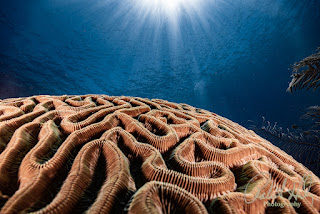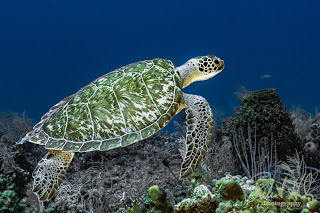Improving Composition with Radial Filters
During a recent presentation I did for a group of divers that I was able to dive with and take underwater pictures of, I was asked how I was able to make my photographs "POP"? Since they were on the same dives and took many of the same pictures of a subject, they were very impressed with the difference in my photos versus theirs. As I usually say to my audiences, it is no longer about who has the best camera or gear; it's all about processing images that make a real difference in pictures. With post-processing tools like Adobe Lightroom, you get the tools that will take average underwater photographs and allow the user to turn them into "WOW" pictures.
Below are just some tools that will allow the user to take an average underwater photograph and turn it into something you can be proud of.
Composition truly matters in underwater photography! How an image is framed and how you direct the viewer's gaze can turn a good photo into a fantastic one. One of my favorite tools for this is Adobe Lightroom's Radial Filter, which helps gently steer the viewer's attention to the subject while keeping everything natural and seamless.
In this post, I'll explore how to use Radial Filters
effectively step-by-step, using five different ways to enhance composition
using this powerful tool. I'll also include Lightroom keyboard shortcuts
to speed up your workflow and a look at how AI-powered masking tools can help.
What is the Radial Filter?
The Radial Filter (Shift + M) in Lightroom allows you to create elliptical or circular adjustments to selectively enhance parts of an image. By adjusting exposure, contrast, clarity, and color within (or outside) the filter, you can subtly draw attention to your subject without making the edits look obvious.
Let’s dive into five effective ways to use Radial Filters to improve composition in your underwater photos.
1. Spotlighting Your Subject for Emphasis
A common issue in underwater photography is that subjects can get lost in the background, especially in busy reef scenes. The Radial Filter allows you to create a subtle spotlight effect, brightening your subject without overexposing it.
Steps:
- Select the Radial Filter tool (Shift + M).
- Click and drag around your subject to create an elliptical selection.
- In the Effects panel, increase the Exposure (+0.3 to +0.7) to subtly brighten the subject.
- Adjust the Feathering (80-100) to blend the effect naturally.
- Use the Invert Mask option if you want to adjust the background instead.
- Press H to hide the pin and preview the effect.
AI Enhancement: Lightroom’s AI-powered Select Subject can identify your main subject. Use this tool (Shift + S) and then refine it with the Radial Filter for more precise control.
2. Creating a Natural Vignette for Depth
A soft vignette around the edges of an image can help frame the subject and reduce distractions from bright or cluttered areas.
Steps:
- Open the Radial Filter (Shift + M).
- Drag a large oval that covers most of the image but leaves space around the edges.
- Increase Feathering (80-100) for a gradual transition.
- To darken the edges subtly, reduce Exposure (-0.3 to -0.5) and Highlights (-10 to -30).
- Adjust Contrast (+10 to +20) if needed to boost the effect.
Pro Tip: Avoid making the vignette too strong, as it can make the effect look artificial. The goal is to guide the viewer’s eyes, not trap them in a tunnel.
3. Enhancing Natural Light Rays
Light rays piercing the water can add dramatic effect, but sometimes they need a little boost.
Steps:
- Select the Radial Filter (Shift + M).
- Drag an elongated oval over the area where the light rays are falling.
- Increase Whites (+10 to +30) and Dehaze (+10 to +20) to enhance Contrast.
- Reduce Clarity (-10 to -20) to create a soft glow.
- If the effect is too strong, you can scale it back using the Amount slider (a Lightroom AI feature).
Pro Tip: Combine this with Linear Gradients (M) for larger light beams.
4. Isolating Small Subjects in Wide Scenes
When photographing tiny critters like nudibranchs in a wide reefscape, a Radial Filter can help them stand out.
Steps:
- Select the Radial Filter (Shift + M).
- Drag an oval around the small subject.
- Increase Clarity (+10 to +30) and Texture (+10 to +20) to make details pop.
- Slightly lower the surrounding areas' Saturation (-5 to -10) to further isolate the subject.
- Use Luminance Masking (Range Mask > Luminance) to adjust only to specific brightness levels.
Pro Tip: Avoid over-sharpening, as this can introduce noise in low-light underwater shots.
5. Softening Backgrounds for a Professional Look
A blurred or softened background helps eliminate distractions and mimics a professional shallow depth-of-field effect.
Steps:
- Select the Radial Filter (Shift + M).
- Drag an oval over the subject.
- Click Invert Mask to apply the effect outside the selection.
- Reduce Clarity (-10 to -30) and Sharpness (-10 to -40) to soften the background.
- Adjust the Feathering (80-100) to blend the effect naturally.
AI Enhancement: The Select Background AI tool can further refine this, making background isolation much easier.
Final Thoughts: Bringing It All Together
Radial Filters are invaluable for underwater photographers looking to enhance composition naturally. Whether emphasizing a subject, creating depth, or enhancing natural light, this tool gives you precise control over how viewers experience your image. Lightroom's AI-powered tools make it even easier by automating selections, allowing you to refine them with Radial Filters for a polished, professional look.
Are you ready to improve your editing? Start experimenting with Radial Filters today, and watch how your images transform!
What's your favorite way to use Radial Filters? Drop a comment below or share your before-and-after edits! If you want to master underwater photo editing, check out my online Lightroom training for Oceanic Explorers—let's make your photos pop! 🌊📸
Written by Robert Herb – empowering underwater photographers to capture and enhance the beauty of our oceans.
Stay Connected
Follow my blog for more tips and tutorials on underwater photography. Let's dive deeper into the art and craft of capturing the marine world!
Subscribe to my blog for more tips and tutorials on underwater photography. Remember to share your processed photos on social media using the hashtag #RobertHerbPhotography. I look forward to reviewing your results.
New Online Training Program
I am excited to announce that I am creating an online training program to teach underwater hobbyists and enthusiasts how to enhance their photos using Adobe Lightroom. If you are interested in this training or need more information, please go to (Underwater Photo Training) or contact me at bob@robertherb.com to express your interest and to be notified about the details and start date of the classes.
Stay tuned and "Follow" for upcoming blogs on underwater photography tips and tricks, which will provide more in-depth insights. Please leave your comments and suggestions. Enjoy your diving and shooting experience!
I am eagerly anticipating your valuable feedback and suggestions.
Sincerely,
Bob Herb
|
|





Comments
Post a Comment
Please let me know your comments.